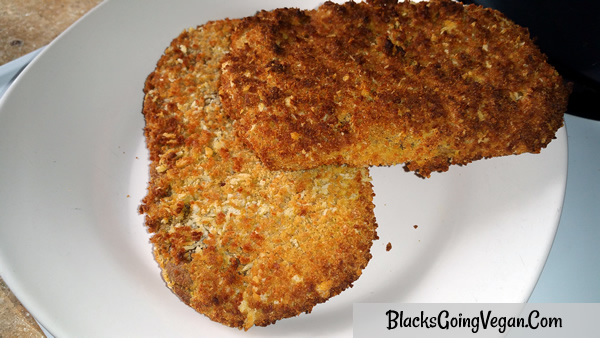Vegan Seitan Cutlets Recipe
What is a Vegan Seitan Cutlet Anyway?
Today’s recipe is a veganized remake of a classic “cutlet” which you probably grew up eating before you converted to veganism. However, in case you aren’t familiar with the term, I found a great definition on The Spruce website, but for brevity, I extracted only the relevant information:
“In the culinary arts, the term cutlet is used to refer to a thin cut of meat usually taken from the leg or rib section of veal, pork or lamb. Chicken or turkey cutlets can be made from a thinly sliced and pounded poultry breast, or from beef cube steak. Cutlets are typically pan-fried, usually after dredging in flour and/or coating them in breadcrumbs.”
These vegan seitan cutlets are so tasty, it’s unbelievable. Often we slice them into thin strips and use a dipping sauce of some concoction, and eat them as a snack.

Or you could slap a seitan cutlet between two pieces of bread and top it with lettuce or spinach, tomato slices, Sriracha ketchup, mustard and vegan mayo for a super tasty sandwich.

You can also offer seitan cutlets as an entree topped with gravy, served with a couple of sides for a delicious dinner.

Making your vegan seitan cutlets ahead and freezing them in their foil packets in a freezer bag will make getting dinner on the table fast and easy.
How to Make Vegan Wheat Meat (Seitan)
We are replacing the protein source used in traditional cutlets with seitan, the high protein, low fat vegan “meat” replacement made from vital wheat gluten. Ounce for ounce, seitan offers double the protein of meat, with none of the cruelty.

Buddhist monks developed seitan in the 6th century, and have creatively use it in dishes of regional cuisines all over Asia to replace meats ever since. Though relatively new to the vegan and vegetarian community here in the U.S., seitan has been around and used by people in other parts of the world for more than 1,000 years. Read the complete post here on BlacksGoingVegan.Com explaining what seitan is: What the #@&$ is Seitan?”
If you have gluten sensitivities or avoid gluten for other dietary reasons, you can still enjoy the benefits of seitan and this fabulous recipe – check out the gluten free seitan recipe found on The Happy Herbivore.
Seasoning and Cooking Vegan Seitan
There are several styles of seiten popular in the vegan community – “chicken” style, “beef” style or the more neutral “vegetable” flavored. There are also several ways to prepare the seitan dough. Depending upon how you ultimately plan to use the seitan you make, you might opt to steam it, bake it, or boil it. Seitan must be cooked FIRST before slicing, cubing or frying it for your recipe.
In this recipe for vegan cutlets, you can choose to flavor your seitan in any way you choose. My preference is for mushroom or Not-Chicken flavor, so that is what I usually make.

The seitan is made soft intentionally, so that there is a texture difference between the crispy coating and the tender cutlet inside. You can fry the cutlets in oil, or use an air fryer – I’ve included pictures of both so you can see what each looks like when done.


Making the Vegan Seitan Cutlets
Get out a large pot for which you have a steamer basket or insert. Sit on stove with it’s top.
Use 2-3 dried shitake mushrooms, 8 pieces dried porcini mushrooms, 6 sun dried tomato halves (not packed in oil), and 1 medium sized Yukon Gold potato which has been peeled and chopped into 1/2″ cubes. Place all of the above in 3 cups of boiling water. Turn off the fire, cover pot, and let sit on stove for about 20 minutes. Remove vegetables from pot and place in blender. Pour the cooking water into the pot with the steamer basket.
Add the rest of the seitan flavoring (wet) ingredients to the blender and blend on high for 30-45 seconds.

While wet mixture is blending, prepare the dry ingredients.
Place vital wheat gluten, seasoning salt, and chickpea flour into a large glass bowl (glass works better because seitan sticks to metal too much). Mix thoroughly with wire whisk before adding wet ingredients.
Make a well in the center by pushing dry ingredients to the side. Start slowly pouring the wet ingredients into the bowl with the dry, stirring with a rubber spatula in widening circles. Once you’ve added all the wet ingredients, dig in with your hands to fully incorporate all dry ingredients.
The dough should be somewhat firm, but pliable enough that you can smooth it with your spatula.

Knead seitan in bowl for 3-4 minutes to develop the gluten. Your vegan seitan cutlet mix will become stretchier and develop a slightly shiny surface. Sit bowl aside and let seitan rest for 15-20 minutes.
While seitan rests, add water to your steaming pot to appropriate level. You do not want water to touch the seitan packets. Heat to a boil, then reduce heat to medium low.

Tear off 8 pieces of aluminum foil about 10″ in length. You will wrap the seiten cutlets up into little envelopes in these pieces of foil.

Remove seitan from bowl and knead another minute or so. Form a rectangular shape and cut the rectangle into 8 pieces. Flatten each piece into cutlets – either rounds, rectangles or squares as desired, about 1/3″ thick. Loosely wrap flattened seiten cutlets in foil, leaving some room for expansion.

Once done, place all 8 pieces in steaming basket in cross-grid fashion. Cover pot and steam seitan cutlets for 35-40 minutes. Turn off heat and let sit in pot for another 15 minutes. Use tongs to remove packets from steamer basket and place on tray or cooling rack before handling so you don’t burn your fingertips.
At this point you can let them cool completely and refrigerate, or place in freezer bags for later use. The cutlets develop a great texture when refrigerated overnight, and are more easily handled and flavorful the next day.
Vegan Seitan Cutlet Spiced Mustard Coating
In a bowl wide enough to dip the seitan pieces in, mix together the flour, thyme leaves, onion powder, garlic powder, black pepper, plant milk, and yellow mustard.

On a separate tray or plate, place about 2 cups of Panko bread crumbs. Dip each piece of vegan seitan cutlet into the mustard coating mix, wipe off excess, then roll it in bread crumbs. Sit aside and repeat. Add more bread crumbs to plate as necessary.

Prepare your air fryer by preheating to 350 degrees, or add a high smoke point oil to frying pan and heat over medium. Best choices for pan frying are peanut, avocado or grapeseed oil, as coconut oil will add a tropical flavor to the cutlets which isn’t what you want to do. Fry until crispy and brown, turning to do the other side.

- 2-3 dried Shitake mushrooms
- 8 pieces dried porcini mushrooms
- 6 sun dried tomato halves (not in oil)
- 1 medium sized Yukon Gold potato, peeled and cut into ½" cubes
- 3 cups of water
- 1 Tablespoon vegetable oil
- 2 large cloves garlic
- 1 teaspoon liquid aminos or Tamari
- 1 Tablespoon Better Than Bouillon Not Beef, Not Chicken or Mushroom seasoning paste
- 1-2/3 cups water
- 2-1/4 cups vital wheat gluten
- 1-2 Tablespoons Santa Maria style seasoning (or other seasoning salt)
- ¼ cup chickpea flour
- ¾ cup all purpose flour
- 2 teaspoons dried thyme leaves
- 2 teaspoons onion powder
- 2 teaspoons garlic powder
- 1 teaspoon fresh ground black pepper
- ¼-1/3 cup prepared yellow mustard
- ⅓ cup plant milk
- Italian seasoned Panko bread crumbs
- 8 Aluminum foil sheets
- Prepare a large pot with a steamer insert. Sit pot and it's top aside.
- Bring 3 cups of water to boil in small saucepan. Place vegetables in boiling water, then turn off heat. Cover pan and let vegetables sit for 20-30 minutes.
- Remove vegetables from pan with slotted spoon and place in blender. Pour cooking water into pot with steamer insert.
- Into the blender add vegetable oil, garlic, water, aminos, black pepper, and Better Than Bouillon. Turn blender on high speed, and blend for 30-45 seconds.
- In a large bowl, combine the vital wheat gluten, seasoning salt, and chickpea flour. Blend well. With a spatula, stir in the liquid ingredients from the blender, pouring slowly to avoid lumps. Once all liquid has been added, mix with spatula as best you can, then dig in with your hands to fully mix all the dry ingredients in.
- Knead the seitan in the bowl for 3-4 minutes to develop the gluten. Let seitan rest in bowl for 15-20 minutes.
- While seitan rests, add water to appropriate level for your steamer. Cut 8 pieces of aluminum foil. Heat water in pot until it boils, then reduce heat to medium.
- Remove seitan from bowl and knead another minute or so. Form seitan into a log shape. Cut log into eight equal pieces. Flatten and shape them as desired on each piece of foil, then loosely fold envelope style. Leave some room for the seitan to expand as it cooks!
- Once all pieces are in foil, place in steaming basket in cross grid fashion and cover pot. Steam seiten for 35-40 minutes, then turn off heat and let sit for 15 minutes.
- Remove foil packets with a pair of tongs and place on try or cooling rack.
- Once cooled you can place in freezer bag for later use, or refrigerate overnight for the best texture and flavor.
- Mix all the ingredients for the mustard coating together and put into a wide bowl large enough for your seitan pieces to lay down flat. Place 2 cups of Panko bread crumbs on a large plate or pan with edges.
- Dip seitan cutlets in mustard coating mix, then coat with bread crumbs. Put right into hot oil and pan fry until golden and crisp outside.
- Alternatively, preheat your air fryer to 350 degrees. Spritz the pan and your coated cutlets with olive oil spray. Place them in air fryer basket with space so all sides are exposed to the heat.
- Cook about 7 minutes or until nicely brown, then turn and cook the other side.
Post pictures and your review of the recipe below! We’d love to see your creation and hear about any modification you make.
Category: Entrees


























Beautiful recipe!!
Do you have a way of making steaming Seitan w/out using foil? I prefer not to cook with foil yet all steamer recipes call for it.
Some people use cheesecloth I’ve heard. The reason why foil is used is because the seitan expands when cooking. The foil gives it a “mold” so to speak, so it can only expand to the thickness and width allowed. If appearance is mandatory (like for an event, party, fancy dinner engagement, etc.) having your cutlets be a uniform size and shape is key. If not, just bake them.
I put the flours on my shopping list and can’t wait to try this. Instead of frying it, can I use this as stew meat?
The texture is rather soft and tender, so I don’t think it would hold up too well in liquids. UNLESS you added it in at the very end of the cooking process. That might work. Hmmm, let me know how it works. Please come and post a pic in your comment.